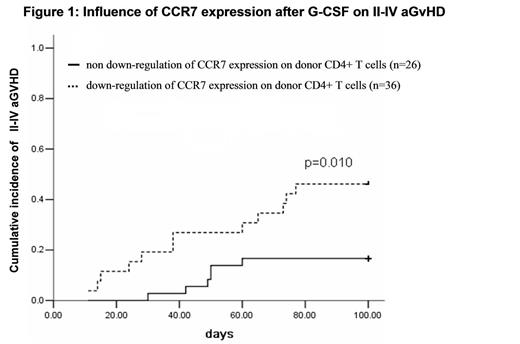Abstract
This study is aimed to investigate chemokine receptors (CCR5, CCR6, CCR7, CCR9, CXCR3 and CCR2) expression on T cell subsets in healthy donors after mobilization with recombinant human granulocyte colony-stimulating factor (rhG-CSF) and analyze its correlation with acute graft-versus-host disease (aGVHD) and to understand the possible mechanisms underlying rhG-CSF-induced immune tolerance.
Sixty-eight healthy donor and their recipient pairs of family donor allogeneic hematopoietic stem cell transplantation (allo-HSCT) were included in this study. The expressions of chemokine receptors on CD4+ and CD8+ T cells in the peripheral blood (PB) before and after mobilization was detected using flow cytometry (FCM) respectively. Six chemokine receptors (CCR2, CCR5, CCR6, CCR7, CCR9 and CXCR3) were detected on T cell subsets in all the donors, and CCR5 and CCR7 were detected only in eighteen of all the donors. The expressions of chemokine receptor before and after mobilization was compared and its correlation with II-IV aGVHD were analyzed.
After rhG-CSF mobilization, the expression of CCR9 on CD4+ T cells and CCR7 on CD8+ T cells were significantly upregulated compared with that before mobilization (p<0.05). However, the mean value of CCR5, CCR6 and CXCR3 expression on CD4+ and CD8+ T cell subsets in PB after mobilization didn’t differ significantly compared with that before mobilization(p>0.10). However, different individuals showed apparent inconsistencies. According to the changes of chemokine receptor expression on CD4+ and CD8+ T cell subsets, the evaluable donors and their relevant recipients were divided into the down-regulated group and the non-down-regulated (unchanged or up-regulated ) group. The incidence of grade II to IV aGVHD in the two groups were compared in their corresponding recipients. In the univariate analysis, mismatched HLA (p=0.046), down-regulation of CCR7 expression on donor CD4+ T cell subsets (p=0.010), unchangeableness or up-regulation of CCR5 expression on donor CD4+ T cell subsets (p=0.032) and CCR6 down-regulation on donor CD8+ T cells (p=0.045) were risk factors for recipients to develop II-IV aGVHD. In the multivariate analysis, down-regulation of CCR7 expression on donor CD4+ T cells after rhG-CSF was independent risk factor for II-IV aGVHD [RR=3.5, 95% CI (1.3-9.4), p=0.012], while CCR5 down-regulation on CD4+ T cells could reduce the incidence of II-IV aGVHD [RR=0.3, 95% CI (0.1-0.8), p=0.031].
rhG-CSF mobilization could lead to differential regulation of chemokine receptors expression on T cell subsets, which might cause different effects on the migration of T cells in vivo, and decrease T cells trafficking towards GVHD target organs, and thus reduce the incidence of aGVHD after transplantation.


No relevant conflicts of interest to declare.
Author notes
Asterisk with author names denotes non-ASH members.

This feature is available to Subscribers Only
Sign In or Create an Account Close Modal